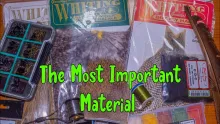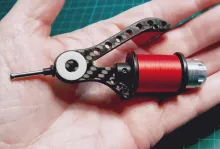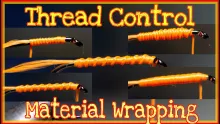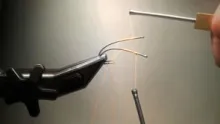GSP or Gel Spun Polyethylene fly tying thread was fairly unknown when Chris Helm wrote this article. His observations still stand.
Some of the issues discussed here, spawned the article Fly Tying Thread Blues, and are covered in depth and with newer information in that article.
There has not been an avalanche of new tying thread over the past fifty years compared with the other new materials available to the modern fly tier. For the first half of the 20th century silk thread was it. Along came nylon, followed later by polyester, and then monofil thread which has limited applications. In the late 1980's a new thread appeared, but for unknown reasons didn’t catch on as it should have given its applicable qualities. Dan Bailey’s introduced European manufactured "DYNACORD" in the late 80's which is when I first started tying with this product. Since the mid 90's a number of distributors have marketed gel-spun thread in various deniers. Unfortunately many fly shops have been reluctant to stock any of these brands of thread, or were simply never introduced to the material. Based on an unscientific informal survey I did earlier this year only one tier out of 150 had heard of gel-spun thread.
Gel-spun polyethylene thread (GSP)
was developed in the late 1980's by Allied Signal (now Honeywell) and simultaneously in Europe by Dutch States Mines in the Netherlands. The Honeywell product is called "Spectra®" and the Dutch version "Dyneema". Gel spun fibers are well suited to the broad range of products including military helmets, bullet resistant vests, parachute cords, cut resistant gloves, and the thread used in sails of various boats in the America’s Cup, just to name a few. This polymer fiber is 40% stronger than aramid fiber. Kevlar®, a product with which most tiers are familiar, is an aramid fiber. GSP is touted to be 10 times stronger than steel.
GSP thread is manufactured
by mixing a solvent with a high molecular weight powder and extruding the mixture through a shower head device known as a "spinneret". This process aligns the molecules of the material that results in the tremendous strength. The continuous fiber thread can be made in a variety of deniers, to accommodate tying very small flies to bass bugs and blue water flies. The breaking strength of these tying threads vary from 2 pounds 8 ounces for the finest denier similar to a 16/0 thread, to 7 pounds 9 ounces for a thread comparable to a 3/0. Keep in mind that the "ought" system is not a standard, but rather an arbitrary size given to the thread by the thread distributor. Denier is the correct standard for measuring thread. Denier is defined as "a unit of fineness for silk, rayon, nylon, etc., yarn equal to the fineness of a yarn weighing one gram for each 9000 meters". As an example, Gudebrod GX2 has a thickness of .002 and a breaking strength of 6 pounds 8 ounces while Danville Monocord (nylon) has a thickness of .0026 and a breaking strength of 1 pound 10 ounces. In a nutshell, gel spun threads are three to five times stronger than nylon or polyester of the same denier.
In addition to strength,
some of the other qualities of gel spun thread that make it a good choice for tying include: it does not absorb water, it floats, it has excellent UV resistance, and it is very supple. The amount of stretch is approximately 3 ½% compared to 16% to 24% for polyester and nylon. This lack of stretch is what makes the standard fishing line Spectra 2000® so sensitive to the take of a fish. The natural color of GSP is white and does not take a dye. However it can be color coated in the manufacturing process or the tier can use a Prismatic Marker or similar permanent marker to change the color. Some distributors do offer five or six colors in a couple of deniers.
In my 10 plus years of tying
with this high tech thread I really haven’t found a down side to using it. Some tiers claim GSP is slippery, which is true. However the tier controls the material, not the other way around, so the slipperiness shouldn’t really be a problem. The slipperiness is actually an advantage when spinning or stacking deer hair. Just a little practice makes using the thread a breeze.
The primary use for this thread
is tying deer hair flies in all sizes and a number of saltwater patterns, or any pattern that thread strength is an essential. Use smaller denier gel spun for spun or stacked deer hair trout flies such as the Goddard Caddis, bombers, irresistibles, and muddlers, etc. putting bar bell eyes on a hook is another example of where this thread is superior to nylon or polyester. The strength combined with the narrowness makes for a secure set of eyes. Adding a drop of Zap-A-Gap provides additional durability.
Should this thread be used
for all tying situations? Probably not because in many situations it is overkill simply because the thread’s extra strength isn’t needed. Standard nylon or polyester thread in appropriate sizes is suitable for probably 75% of what most tiers create at the vise. I used Gudebrod GX2 to tie all of my hair bugs because the thread allows for securing the hair to the hook properly to eliminate "rolling" of the body. Multiple stacks of hair can be flared on top of each other and appropriate pressure applied to assure that all of the hair flares to achieve a thick density.
In case you are wondering,
no, gel spun thread doesn’t cut the hair, the tier cuts the hair because of applying too much pressure. This is a common complaint that I’ve heard from many tiers about Kevlar®. Although I haven’t devised a method for testing the abrasiveness of thread, it is possible that Kevlar® might cut a large clump of deer hair with slightly less pressure than nylon, polyester, or GSP thread. However the difference in pressure is likely to be relatively insignificant. The key to developing the touch with any thread is much in the same manner as a skilled golfer develops a putting stroke on the green. It takes experimentation and practice!
An exercise to use with GSP thread
is to pull on the thread until the hair or other material is cut. By repeating this process several times you will soon learn when to cease increasing the pressure. You’ll be at the 90 plus percentile of the materials breaking point. After some practice it will become second nature just how hard to pull.
The GSP threads available from Europe
include DYNACORD 8/0 and 3/0, UNI Cord 12/0 and 7/0 (the same thread with a different brand name and size designation), Benecchi Ultra Strong (no size designation, but my guesstimate is an 8/0), and Roman Moser Power Silk (again no size designation, but most likely a 12/0 or 14/0).
GSP thread available from US manufacturers/distributors include Gudebrod GX2 (ideal for hair bass bugs and saltwater applications), WAPSI Gel Spun (about the size of a 6/0), and Cascade Crest Tools GSP that is similar to DYNACORD 3/0 or UNI Cord 7.0 in denier and strength.
Most GSP threads come on spools
with either 50 yards or 50 meters. The cost per spool ranges from $3.00 to $6.00. Some tiers have complained that this is too much money for thread. I would strongly disagree. When considering the characteristics of the thread and how much easier it makes tying specific fly patterns where nylon and polyester come up short, the cost is way overrated. A spool of Gudebrod GX2 will tie around 100 bass bugs if the thread is only used for application of the hair. At $3.75 per spool that equates to just under four cents per fly which doesn’t seem very expensive. If I am tying a standard hair bug with hackle tails, etc., a thread such as Gudebrod 6/0 or WAPSI 140 denier would be used to secure the tail material. You owe it to yourself to experiment with this high tech thread. You’ll find that the GSP thread is superb for specific applications where extra strength and small denier is essential.
Hand picked for this article
- Log in to post comments










